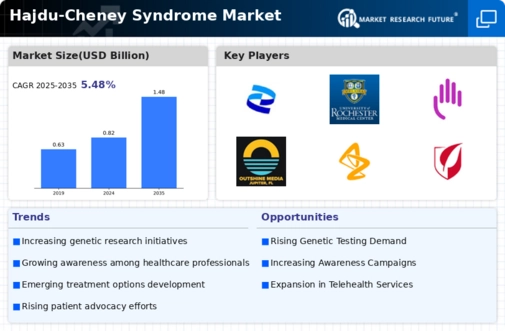Growing Patient Advocacy Groups
The emergence of patient advocacy groups plays a crucial role in the Global Hajdu-Cheney Syndrome Market Industry. These organizations work tirelessly to raise awareness, provide support, and advocate for research funding related to Hajdu-Cheney Syndrome. Their efforts help to connect patients with resources and information, fostering a sense of community among those affected by the condition. As these groups gain traction, they contribute to the overall growth of the market by promoting the need for better diagnostic and treatment options, thereby enhancing the visibility of Hajdu-Cheney Syndrome.
Advancements in Genetic Research
Ongoing advancements in genetic research significantly contribute to the Global Hajdu-Cheney Syndrome Market Industry. Innovations in gene therapy and precision medicine are paving the way for targeted treatments that address the underlying causes of genetic disorders. These advancements not only enhance the understanding of Hajdu-Cheney Syndrome but also facilitate the development of novel therapeutic approaches. As research continues to evolve, the market is expected to grow, with projections indicating a rise to 1.48 USD Billion by 2035, driven by the potential for groundbreaking treatments.
Rising Awareness of Genetic Disorders
The increasing awareness of genetic disorders, including Hajdu-Cheney Syndrome, is a pivotal driver for the Global Hajdu-Cheney Syndrome Market Industry. As healthcare professionals and the general public become more informed about rare genetic conditions, the demand for diagnostic testing and treatment options is likely to rise. This heightened awareness may lead to earlier diagnosis and intervention, potentially improving patient outcomes. In 2024, the market is projected to reach 0.82 USD Billion, reflecting the growing recognition of genetic disorders and the need for specialized care.
Increased Funding for Rare Disease Research
The Global Hajdu-Cheney Syndrome Market Industry benefits from increased funding for rare disease research. Governments and private organizations are allocating more resources to understand and treat rare genetic disorders. This financial support fosters innovation and encourages the development of new therapies and diagnostic tools. As a result, the market is likely to experience growth, with a compound annual growth rate of 5.49% projected from 2025 to 2035. This influx of funding not only enhances research capabilities but also raises awareness about Hajdu-Cheney Syndrome, ultimately benefiting patients.
Global Collaboration in Healthcare Initiatives
Global collaboration in healthcare initiatives is a significant driver for the Global Hajdu-Cheney Syndrome Market Industry. International partnerships among researchers, healthcare providers, and pharmaceutical companies facilitate the sharing of knowledge and resources, leading to improved understanding and treatment of Hajdu-Cheney Syndrome. These collaborations can accelerate the development of new therapies and enhance patient access to care. As the market evolves, such cooperative efforts are expected to contribute to its growth, aligning with the increasing demand for effective solutions for rare genetic disorders.





















Leave a Comment